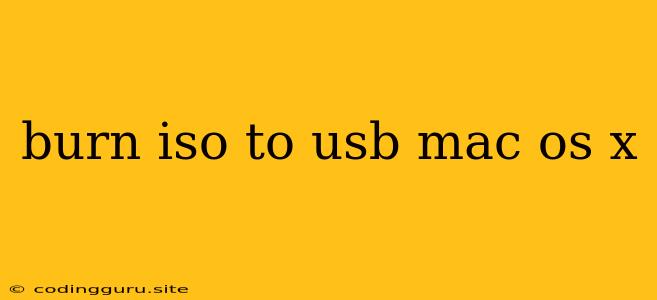How to Burn an ISO to a USB Drive on macOS X
Creating a bootable USB drive with an ISO image is a common task for many users, especially when installing or reinstalling macOS X. It allows you to create a bootable installer that you can use to install the operating system on a computer or repair an existing installation.
What is an ISO Image?
An ISO image is a file that contains the entire contents of a CD or DVD. It's a single file that can be used to create a bootable disk, which is essential for installing operating systems or software.
Why Burn an ISO to a USB Drive?
There are several reasons why you might want to burn an ISO to a USB drive:
- Installing macOS X: Creating a bootable USB installer is the most convenient way to install macOS X on a Mac.
- Reinstalling macOS X: If your macOS X installation is corrupt or you need to start fresh, a bootable USB drive can help you reinstall the operating system.
- Creating a bootable backup: You can use a bootable USB drive to create a backup of your entire macOS X system, allowing you to recover from a hard drive failure.
- Running macOS X on another computer: You can use a bootable USB drive to install macOS X on a non-Mac computer (with certain limitations).
Steps to Burn an ISO to a USB Drive on macOS X
Here's how to burn an ISO image to a USB drive on macOS X using the built-in Disk Utility application:
- Download the ISO image: Make sure you have the correct ISO image for the macOS X version you want to install. You can download it from the Apple website or other reliable sources.
- Connect your USB drive: Connect your USB drive to your Mac. Ensure it has enough storage space for the ISO image.
- Open Disk Utility: Open the "Disk Utility" application, found in your "Applications" folder.
- Select your USB drive: In Disk Utility's window, select your USB drive from the left-hand sidebar.
- Format the USB drive:
- Click the "Erase" tab.
- Choose "Mac OS Extended (Journaled)" as the format.
- Give your USB drive a name.
- Click "Erase".
- Important: This will erase all data on your USB drive. Make sure you have backed up any important files before formatting.
- Open Terminal: Open the "Terminal" application, found in your "Applications" folder.
- Mount the ISO image: In the Terminal window, type the following command, replacing "your_iso_image.iso" with the actual name of your ISO file:
hdiutil attach your_iso_image.iso - Find the mounted volume: Look for the name of the mounted volume (it will typically be something like "Install macOS X") in the Terminal window or in Disk Utility.
- Copy files to the USB drive: Use the
cpcommand to copy the contents of the mounted volume to your USB drive. For example, to copy the files to a USB drive named "MyUSB", run the following command:cp -r /Volumes/Install\ macOS\ X/* /Volumes/MyUSB - Unmount the ISO image: Once the files are copied, unmount the ISO image by running the following command in Terminal:
hdiutil detach /Volumes/Install\ macOS\ X
- Eject the USB drive: Safely eject your USB drive from your Mac. You have successfully created a bootable USB installer.
Troubleshooting Tips
- Make sure you are using the correct ISO image: Double-check the version and compatibility of the ISO image you're using with your Mac.
- Check your USB drive's format: The USB drive should be formatted as Mac OS Extended (Journaled).
- Verify the integrity of the ISO image: Ensure that the ISO image you downloaded is not corrupted.
- Use the correct command: Be sure to use the correct commands in the Terminal, replacing the file names and paths with your actual file names and paths.
- Use the correct version of Disk Utility: Older versions of Disk Utility may not support burning ISOs to USB drives. Make sure you are using a recent version of macOS X.
Important Notes
- Burning an ISO to a USB drive will erase all existing data on the USB drive. Always back up any important files before formatting.
- Some macOS X versions require specific USB drives (for example, a USB 3.0 drive may be required for later versions).
Conclusion
Creating a bootable USB drive from an ISO image on macOS X is a straightforward process. By following these steps, you can easily create a bootable installer that can be used to install or reinstall macOS X. Remember to use the correct ISO image and format your USB drive correctly. With the right tools and a few simple commands, you can create a bootable USB drive in no time.
